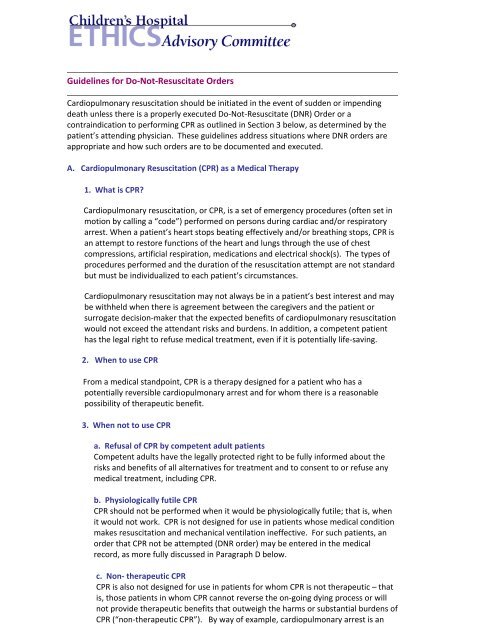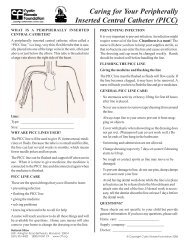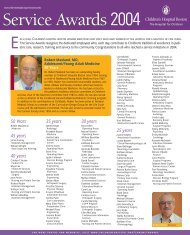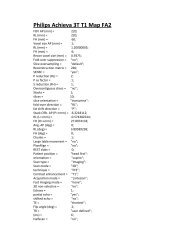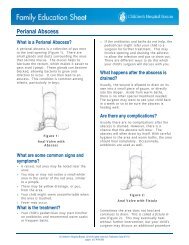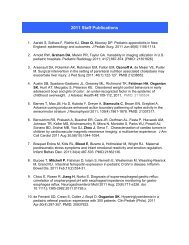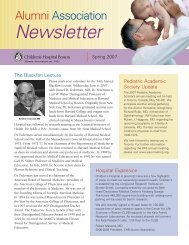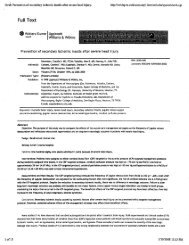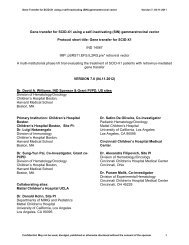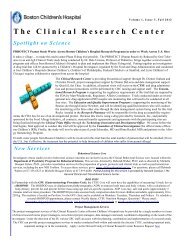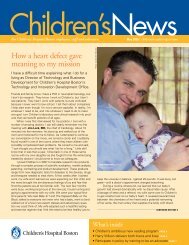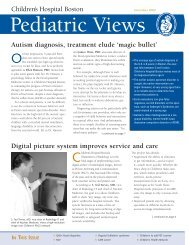Guidelines for Do-Not-Resuscitate Orders - Children's Hospital Boston
Guidelines for Do-Not-Resuscitate Orders - Children's Hospital Boston
Guidelines for Do-Not-Resuscitate Orders - Children's Hospital Boston
You also want an ePaper? Increase the reach of your titles
YUMPU automatically turns print PDFs into web optimized ePapers that Google loves.
<strong>Guidelines</strong> <strong>for</strong> <strong>Do</strong>‐<strong>Not</strong>‐<strong>Resuscitate</strong> <strong>Orders</strong><br />
Cardiopulmonary resuscitation should be initiated in the event of sudden or impending<br />
death unless there is a properly executed <strong>Do</strong>‐<strong>Not</strong>‐<strong>Resuscitate</strong> (DNR) Order or a<br />
contraindication to per<strong>for</strong>ming CPR as outlined in Section 3 below, as determined by the<br />
patient’s attending physician. These guidelines address situations where DNR orders are<br />
appropriate and how such orders are to be documented and executed.<br />
A. Cardiopulmonary Resuscitation (CPR) as a Medical Therapy<br />
1. What is CPR?<br />
Cardiopulmonary resuscitation, or CPR, is a set of emergency procedures (often set in<br />
motion by calling a “code”) per<strong>for</strong>med on persons during cardiac and/or respiratory<br />
arrest. When a patient’s heart stops beating effectively and/or breathing stops, CPR is<br />
an attempt to restore functions of the heart and lungs through the use of chest<br />
compressions, artificial respiration, medications and electrical shock(s). The types of<br />
procedures per<strong>for</strong>med and the duration of the resuscitation attempt are not standard<br />
but must be individualized to each patient’s circumstances.<br />
Cardiopulmonary resuscitation may not always be in a patient’s best interest and may<br />
be withheld when there is agreement between the caregivers and the patient or<br />
surrogate decision‐maker that the expected benefits of cardiopulmonary resuscitation<br />
would not exceed the attendant risks and burdens. In addition, a competent patient<br />
has the legal right to refuse medical treatment, even if it is potentially life‐saving.<br />
2. When to use CPR<br />
From a medical standpoint, CPR is a therapy designed <strong>for</strong> a patient who has a<br />
potentially reversible cardiopulmonary arrest and <strong>for</strong> whom there is a reasonable<br />
possibility of therapeutic benefit.<br />
3. When not to use CPR<br />
a. Refusal of CPR by competent adult patients<br />
Competent adults have the legally protected right to be fully in<strong>for</strong>med about the<br />
risks and benefits of all alternatives <strong>for</strong> treatment and to consent to or refuse any<br />
medical treatment, including CPR.<br />
b. Physiologically futile CPR<br />
CPR should not be per<strong>for</strong>med when it would be physiologically futile; that is, when<br />
it would not work. CPR is not designed <strong>for</strong> use in patients whose medical condition<br />
makes resuscitation and mechanical ventilation ineffective. For such patients, an<br />
order that CPR not be attempted (DNR order) may be entered in the medical<br />
record, as more fully discussed in Paragraph D below.<br />
c. Non‐ therapeutic CPR<br />
CPR is also not designed <strong>for</strong> use in patients <strong>for</strong> whom CPR is not therapeutic – that<br />
is, those patients in whom CPR cannot reverse the on‐going dying process or will<br />
not provide therapeutic benefits that outweigh the harms or substantial burdens of<br />
CPR (“non‐therapeutic CPR”). By way of example, cardiopulmonary arrest is an
expected terminal occurrence in patients with certain diseases or conditions who<br />
are nearing the end of their life span. In such cases, CPR may temporarily restore<br />
cardiac function but the patient’s overall condition will worsen and<br />
cardiopulmonary arrest will occur again as a natural and inevitable part of the<br />
dying process. Providing CPR in such cases is likely to harm the patient and<br />
contravenes the medical ethics (including the principle of “do no harm”) of<br />
clinicians. For such patients, a DNR order is appropriate so that CPR will not be<br />
attempted.<br />
B. Role of Patient and Parents of Minor Children<br />
The patient and parents (or legal guardian) should be involved in making decisions<br />
about CPR. As with other clinical decisions, parents of minor children should be fully<br />
in<strong>for</strong>med about medical recommendations regarding CPR and DNR, and minor children<br />
should participate to the fullest extent of their developmental abilities and emotional<br />
state. Generally, a DNR order should not be entered into the patient’s medical record<br />
without concurrence of the parents. However, a DNR order may be entered by the<br />
patient’s physician without parental permission if CPR is determined to be<br />
physiologically futile or non‐therapeutic, in accordance with Paragraphs E and F below.<br />
C. <strong>Do</strong>cumentation of a <strong>Do</strong> <strong>Not</strong> <strong>Resuscitate</strong> (DNR) order<br />
<strong>Do</strong>cumentation in the patient’s medical record of a decision not to do CPR must<br />
include both a Physician’s Order and an entry in the Progress <strong>Not</strong>es. Use of the<br />
standardized DNR Order Form is preferred, but is not required in cases where the<br />
attending physician prefers a narrative method of documentation.<br />
<strong>Do</strong>cumentation in the Progress <strong>Not</strong>es should include the following and be written or<br />
co‐signed by the attending physician:<br />
1. Why and how the initial question of resuscitation status was raised.<br />
2. Decision making process which has been and will be followed:<br />
a. Professional staff involvement;<br />
b. Role of parents and patient;<br />
c. Data upon which decision is based.<br />
3. Summary and update of planning process and decision.<br />
4. Summary of conversations with patients and parents.<br />
Subsequent progress notes should document re‐evaluation of the patient’s<br />
condition on a timely basis, continued appropriateness of the DNR order, and<br />
family involvement.<br />
Discussion(s) regarding resuscitation status with the patient and/or family are the<br />
responsibility of the attending physician. The Physician’s Order, whether utilizing<br />
the standardized <strong>for</strong>m or a narrative <strong>for</strong>mat, must be signed by an attending<br />
physician and nurse. When the patient’s attending physician is not immediately<br />
available to sign the order, then a house staff physician may sign the order, after<br />
conferring with the attending physician over the phone to verify the<br />
appropriateness of the order, and document this conversation in the chart. Under<br />
these circumstances, the attending physician must physically sign the <strong>for</strong>m as soon<br />
as possible and in any case no later than 24 hours after the order is entered into<br />
the patient’s medical record. In addition, an expiration date, if any, should be set<br />
<strong>for</strong>th in the orders.<br />
In the remainder of this policy, the term “Parent(s)” will be used to refer to the legally authorized<br />
decision‐maker(s) <strong>for</strong> a child and should be understood to refer to the legal guardian when appropriate.<br />
When the patient is a competent adult, the patient is the legally authorized decision‐maker.
The primary nurse and attending physician (or their designees) are responsible <strong>for</strong><br />
ensuring that all pertinent caregivers are aware of the DNR Order. Whenever<br />
possible, medical and nursing staff from other units or facilities who will be<br />
providing care, or who will resume care, should be involved in discussions about a<br />
DNR Order to enable understanding and continuity of care.<br />
D. Entry of DNR order in cases of disagreement between clinical staff and parent(s)<br />
In almost all circumstances, parents and clinical staff should reach agreement<br />
about whether a DNR order is appropriate <strong>for</strong> the patient based on the patient’s<br />
prognosis, the risks of harm and potential benefits, if any, that may be expected of<br />
CPR, and the values of the parent(s) and patient. Nevertheless, on rare occasions,<br />
parents may request CPR even though the clinical team has concluded that CPR is<br />
either physiologically futile or not therapeutic. The process <strong>for</strong> dealing with such<br />
disagreements depends on the reason CPR is considered inappropriate.<br />
When there is agreement among clinical staff caring <strong>for</strong> the patient (i.e. the clinical<br />
team) that CPR is physiologically futile, parents should be in<strong>for</strong>med and told that a<br />
DNR order will be written in the chart. Parents who disagree with the clinical<br />
decision not to do CPR should be given a reasonable opportunity to obtain a<br />
second opinion or transfer the patient unless the child’s condition precludes doing<br />
so. Clinical staff are not required to per<strong>for</strong>m physiologically futile and harmful<br />
treatments on a patient.<br />
When there is agreement among clinical staff caring <strong>for</strong> the patient that CPR is<br />
non‐therapeutic and that per<strong>for</strong>ming CPR violates their medical‐ethical duty to the<br />
patient, and if parents still want CPR to be per<strong>for</strong>med, the clinical team should<br />
initiate a process of review to determine whether a DNR order may be entered<br />
despite the disagreement of the parent(s).<br />
E. Process <strong>for</strong> reviewing disagreements about whether CPR is therapeutic<br />
If the patient’s clinical team has concluded that per<strong>for</strong>ming CPR on the patient<br />
would not be therapeutic, and if the team has been unable to reach agreement<br />
with the parents about entering a DNR order, then staff and/or parents should<br />
initiate the following review process:<br />
a. The clinical staff should confirm that members of the patient’s clinical team<br />
are in agreement that CPR should not be per<strong>for</strong>med on the patient because it<br />
is non‐ therapeutic.<br />
b. A second opinion should be obtained from a physician not on the patient’s<br />
clinical team about whether CPR is non therapeutic.<br />
c. If the second opinion supports the conclusion of the clinical team, a member of<br />
the clinical team should contact the Ethics Office to schedule an ethics consult.<br />
d. <strong>Hospital</strong> staff will work actively with the patient’s parent(s) and other care<br />
providers (such as the patient’s primary care physician, school nurses, group<br />
home staff, etc.) to appreciate their concerns and plan <strong>for</strong> care without CPR.<br />
e. If the ethics consult supports entry of a DNR order despite the parents’<br />
disagreement, the clinical staff should in<strong>for</strong>m the Chief of Service and the Legal<br />
Office.<br />
f. If the Service Chief concurs, and if the legal office confirms that judicial<br />
involvement is not necessary, the parents should be told that a DNR order will<br />
be entered into the patient’s medical record.<br />
g. Parents should be given a reasonable opportunity and assistance to transfer<br />
the patient to another facility willing to accept the patient.
h. If it is not possible to transfer the patient, a DNR order may be entered into the<br />
patient’s medical record.<br />
F. Mandatory Reassessment of DNR <strong>Orders</strong> Be<strong>for</strong>e Anesthetic and Surgical<br />
Procedures<br />
Patients with DNR orders may be appropriate candidates <strong>for</strong> anesthesia and<br />
surgery, especially <strong>for</strong> procedures intended to facilitate care or relieve pain. The<br />
etiologies and outcomes of cardiac arrest during anesthesia are sufficiently<br />
different from those in non‐surgical settings that re‐evaluation of the DNR order is<br />
always necessary. The fact that cardiac arrest is more likely to be reversible when it<br />
occurs during anesthesia will often mean that it is in the patient’s best interest to<br />
have the DNR order suspended during the intra‐operative and immediate post‐<br />
operative periods. In some cases, however, patients or their parents may desire<br />
limitations on the resuscitative procedures used throughout the perioperative<br />
period.<br />
The administration of anesthesia necessarily involves some practices and<br />
procedures that might be viewed as “resuscitation” in other settings. For example,<br />
routine anesthetic care usually requires placement of an intravenous catheter,<br />
administration of intravenous fluids and medications, and management of the<br />
patient’s airway and respiration. Chest compressions and electrical cardio‐version,<br />
on the other hand, are generally not intrinsic to the anesthetic or surgical<br />
procedure.<br />
The anesthesiologist, in conjunction with the patient’s other attending physicians,<br />
is responsible <strong>for</strong> discussing these issues with the patient and/or family, reassessing<br />
the patient’s DNR status prior to surgery, and communicating these decisions to<br />
those who will be involved with the patient’s care during the intra‐operative and<br />
immediate post‐operative period.<br />
The hospital’s standardized DNR Order <strong>for</strong>m may not be the best tool <strong>for</strong><br />
considering and documenting DNR status during the perioperative period.<br />
Alternatively, agreement with the patient and/or family on one of the following<br />
three options may meet the needs of most patients with DNR status who require<br />
anesthesia and surgery:<br />
Option #1: Full Resuscitation<br />
The patient desires that full resuscitative measures be employed during surgery<br />
and in the PACU, regardless of the clinical situation.<br />
Option #2: Limited Resuscitation: Procedure‐Specific<br />
The patient desires that full resuscitative measures be employed, with the<br />
exception of certain specific procedures, such as chest compressions or electrical<br />
cardio version. As noted above, however, certain procedures are essential to<br />
providing the anesthetic care (such as airway management and intravenous fluids).<br />
Refusal of these procedures would not be consistent with a request <strong>for</strong> anesthesia<br />
and surgery.<br />
Option #3: Limited Resuscitation: Goal‐Specific<br />
The patient desires resuscitative ef<strong>for</strong>ts during surgery and in the PACU only if the<br />
adverse clinical events are believed to be both temporary and reversible, in the<br />
clinical judgment of the attending anesthesiologists and surgeons. This option<br />
requires the patient and/or surrogate to trust the judgment of the<br />
anesthesiologists and other caregivers to use resuscitative interventions<br />
judiciously, based upon their understanding of the patient’s values and goals of<br />
treatment.
One of the options outlined above, or another if appropriate, should be<br />
documented in the Progress <strong>Not</strong>es. The original DNR order should be reinstituted<br />
at the time the patient leaves the care of the anesthesiologist (upon transfer out of<br />
the OR or PACU), unless otherwise documented.<br />
If the patient/parent(s) elects to have the DNR order remain in effect during<br />
anesthesia and surgery, physicians and other caregivers have the option of<br />
declining to participate in the case. Should any caregiver decline to participate, he<br />
or she must make a reasonable ef<strong>for</strong>t to find another who is willing to treat the<br />
patient.<br />
G. Patients who are 18 or Older<br />
As a general rule, patients who are 18 years of age or older are entitled to make<br />
decisions on their own behalf. However, in certain cases, when children over the<br />
age of 18 are not able to make their own decisions (are “incapacitated”), parents<br />
may be authorized to make decisions on their behalf.<br />
1. Parents of children who are mentally incapacitated may have been given<br />
authority by the court to serve as guardians <strong>for</strong> their children.<br />
2. Parents may have been designated health care agents or proxies in their adult<br />
child’s advance directive after the child turned 18, and thus are authorized to<br />
make decisions when their child is no longer capable of doing so.<br />
3. In certain circumstances, even absent a court order or an advance directive,<br />
parents may be the appropriate surrogates <strong>for</strong> their adult child (just as a<br />
spouse or child may be the appropriate surrogate <strong>for</strong> an adult who has not<br />
completed an advance directive). By way of example, parents of a child with a<br />
chronic, degenerative illness may be the appropriate surrogate <strong>for</strong> their child in<br />
the event a decision must be reached about DNR and the child no longer has<br />
decision‐making capacity (but did not complete an advance directive). Parents<br />
may also be the appropriate surrogates <strong>for</strong> a child over 18 who become ill or<br />
injured unexpectedly and is unable to make decisions on his/her own behalf.<br />
Legal counsel should be contacted in these circumstances.<br />
H. Discontinuation of a DNR Order<br />
A DNR order may be revoked by a competent patient or surrogate decision‐maker,<br />
unless the DNR order has been entered because CPR is physiologically futile, or<br />
because it has been determined to be non therapeutic, provided the review<br />
process set <strong>for</strong>th in Paragraph E has supported such determination. Any member<br />
of the clinical staff or family may request that a DNR order be re‐evaluated.<br />
Discontinuation of the DNR order must be noted in the appropriate place on the<br />
DNR Order Sheet (or documented in the Physician’s <strong>Orders</strong> if a DNR Order Sheet is<br />
not used), and explained in the Progress <strong>Not</strong>es.<br />
I. Ethical Concerns<br />
The <strong>Hospital</strong> Ethicist and Ethics Advisory Committee are available to any member of<br />
the health care team, family, and patient, <strong>for</strong> advice about ethical concerns,<br />
including decisions about resuscitation or other life‐sustaining treatments. The<br />
Office of Ethics can be reached at x6920 and an Ethicist is always available by<br />
pager.
J. Legal Considerations<br />
If clinical staff believe legal consultation is necessary or might prove helpful, an<br />
attorney with the <strong>Hospital</strong>’s Office of General Counsel should be contacted at<br />
x6800 or, if urgent, by pager. For example, when a child is in state custody through<br />
Massachusetts Department of Children and Families, an ethics committee<br />
consultation and court review of decisions to limit life‐sustaining treatments is<br />
legally required. <strong>Hospital</strong> counsel might also be consulted when guardians or<br />
attorneys are involved on behalf of the child and/or parent(s), or when there are<br />
concerns about conflict, consent or documentation.<br />
K. DNR orders <strong>for</strong> Emergency Medical Technicians (EMTs)<br />
The Massachusetts Department of Public Health’s Office of Emergency Medical<br />
Services has developed the COMFORT CARE DNR Verification program to provide a<br />
mechanism <strong>for</strong> EMTs and First Responders to identify patients who have DNR<br />
orders and to initiate a protocol focused upon com<strong>for</strong>t and palliative care rather<br />
than automatic emergency CPR. The patient’s DNR status is indicated by a<br />
standardized state <strong>for</strong>m that must be immediately available to EMS personnel<br />
and/or an orange bracelet on the patient’s arm. The attending physician is<br />
responsible <strong>for</strong> determining whether a patient needs a DNR verification order and<br />
<strong>for</strong> completing the CC/DNR Form and Bracelet, providing a copy <strong>for</strong> the parent(s)<br />
and placing a copy of the CC/DNR <strong>for</strong>m in the patient’s medical record. The<br />
appropriate <strong>for</strong>ms and in<strong>for</strong>mational brochures are available on the Critical Care<br />
units, or may be obtained from the MICU Office (x7327), the Office of Ethics<br />
(x6920), the Office of General Counsel (x6800), or online at<br />
http://www.mass.gov/eohhs/provider/guidelines‐resources/clinical‐treatment/com<strong>for</strong>t‐care/<br />
Since the CC/DNR program applies only to EMTs and First Responders, the<br />
attending physician may also want to provide a statement on the physician’s<br />
letterhead and/or a copy of the Children’s <strong>Hospital</strong> DNR <strong>for</strong>m to provide non‐<br />
binding guidance to others who may need in<strong>for</strong>mation regarding the patient’s<br />
resuscitation status, such as visiting nurses or emergency physicians at Children’s<br />
<strong>Hospital</strong> or other institutions. As a general rule, valid CC/DNR Forms or Bracelets<br />
will be honored by the medical and nursing staff of Children’s <strong>Hospital</strong> Emergency<br />
Department and in the Children’s <strong>Hospital</strong> Ambulatory Clinics.<br />
Approved MSEC 9/98<br />
Revised 7/99<br />
Revised /2009<br />
Approved MSEC 1/2012


